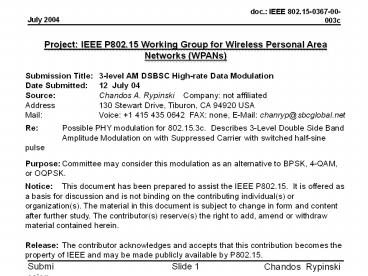3-level AM DSBSC High Rate Data Modulation PowerPoint PPT Presentation
Title: 3-level AM DSBSC High Rate Data Modulation
1
Project IEEE P802.15 Working Group for Wireless
Personal Area Networks (WPANs) Submission Title
3-level AM DSBSC High-rate Data Modulation Date
Submitted 12 July 04 Source Chandos A.
Rypinski Company not affiliated Address 130
Stewart Drive, Tiburon, CA 94920 USA
Mail Voice 1 415 435 0642 FAX none,
E-Mail chanryp_at_sbcglobal.net Re Possible PHY
modulation for 802.15.3c. Describes 3-Level
Double Side Band Amplitude Modulation on with
Suppressed Carrier with switched half-sine pulse
Purpose Committee may consider this modulation
as an alternative to BPSK, 4-QAM, or
OQPSK. Notice This document has been prepared to
assist the IEEE P802.15. It is offered as a
basis for discussion and is not binding on the
contributing individual(s) or organization(s).
The material in this document is subject to
change in form and content after further study.
The contributor(s) reserve(s) the right to add,
amend or withdraw material contained
herein. Release The contributor acknowledges
and accepts that this contribution becomes the
property of IEEE and may be made publicly
available by P802.15.
2
3-level AM DSBSC High-rate Data Modulation
- Chandos A. Rypinski, consultant
- With Bob Ritter and John Arminini
- 12 July 2004
3
Summary
- A different digital modulation technique is
recommended to as an alternative to BPSK and
OQPSK for short-reach, very high data rate UWB
personal area networks. These applications are
distinguished from narrow band systems because a
higher level of side lobes is acceptable. - The recommended baseband modulation is DSBSC
(double-sideband suppressed carrier) with three
amplitude levels. This modulation enables
homodyne receivers with I-Q demodulator working
at a lower signal level. It is thought to be an
excellent trade-off between complexity of
implementation and performance.
4
Advantages and Differentiation (1)
- Zero dc and reduced low frequency energy density
below 10 of the high edge frequency of the power
density spectrum. This modulation enables
homodyne receivers with I-Q demodulator working
at a low signal level. - In the context of UWB, higher rejection for
strong out-of-band signals is achievable by
moving channel selectivity closer in level to the
antenna. - Relatively fast acquisition for AGC setting and
synchronization of the bit-clock.
5
Advantages and Differentiation (2)
- Independence of rf phase or frequency at
demodulation provides decreased susceptibility to
phase reversal errors with frequency/time domain
fades. - With specified channel coding, half the bits are
0's transmitted at zero amplitude enabling 1's to
be transmitted at twice the average power allowed
for BPSK. - This baseband waveform will pass through Category
5 copper pairs for substantial distances without
equalizers.
6
Compare isolated Sym-pulse and sine pulses
- Figure 1 Isolated pulse for one-bit sine-wave
and sym-pulse
- Figure 2 Power density spectrum for sine-wave
and sym-pulse isolated pulses
7
Serial bit stream using concatenated sine pulses
8
Estimating Occupied Bandwidth for Sine Pulse
- The video waveforms shown above may be converted
to DSB-SC radio frequency with a diode ring mixer
in which the LO is the new carrier frequency and
the video is the linear signal at the IF port. - For 3-level am video 0.04 to 0.9 times bit/chip
rate for -18 dB at edges - For 3-level DSB-SC 1.8 times bit/chip rate for
-18 dB at edges - Example
- For 100 Mbps, the video bandwidth is about 4 to
90 MHz, and the radio bandwidth is about 180 MHz
at -18 dB down at edge and beyond.
9
Receiver data demodulation (1)
- At signal or intermediate frequency, an I-Q
demodulator with local oscillator reduces the
signal to baseband video - Each channel is squared and the result added
implementing the identity sin²(?)cos²(?) 1.
The sum is proportional to the power amplitude of
the signal independently of the phase and
frequency of the LO. - The peak amplitude of this signal is used for
feed back AGC regulating the signal to within a
few dB.
10
Receiver data demodulation (2)
- The approximately regulated signal is measured
continuously for peak value. The threshold for a
data comparator is set at a fixed fraction (near
70). - The amplitude is integrated over the center half
of the bit interval, and the value is determined
by the comparator at the end of the integration
interval. A data value of 1 or 0 is then
available for the current bit. - This circuit requires known bit clock timing
which is established during the burst preamble.
11
Limitations on Maximum Rate
- The present ASICs used for the receive vector
demodulator and for the squaring circuit may
limit speed to 50 Mbps. Faster circuits could be
implemented with diode ring mixers and more
components. - Because flat delay across the passband is needed,
analog filters are limited in available
selectivity. - Because of sampling at 4-5 times bit rate, the
implementation is difficult for FIR filters.
12
Recommendation
- The described modulation is recommended for use
with mmWave radio transmission because it will
ease many implementation problems, survive
various types of propagation degradation and its
processing at high speed will require less power
than mathematical methods. - Chandos Rypinski

